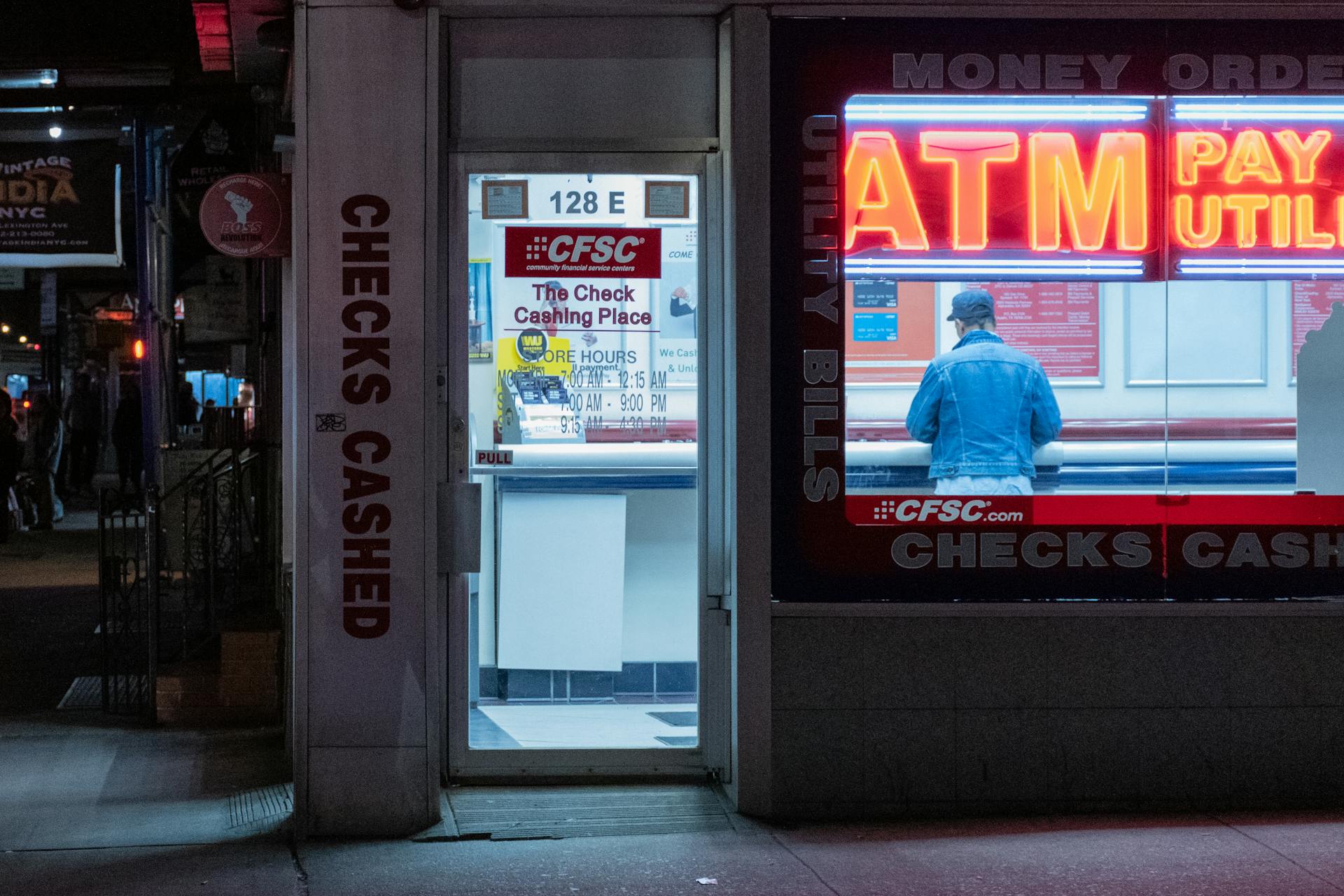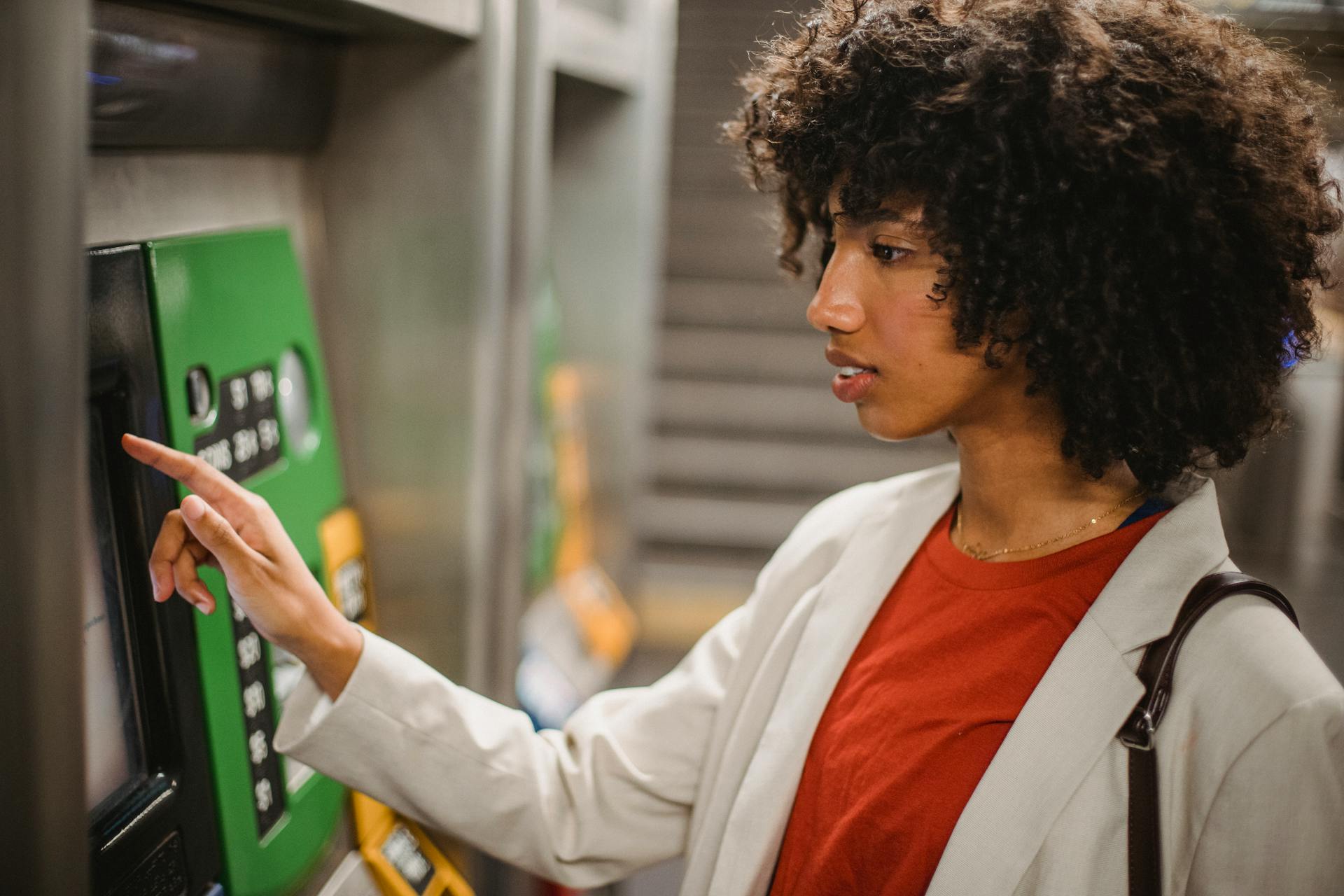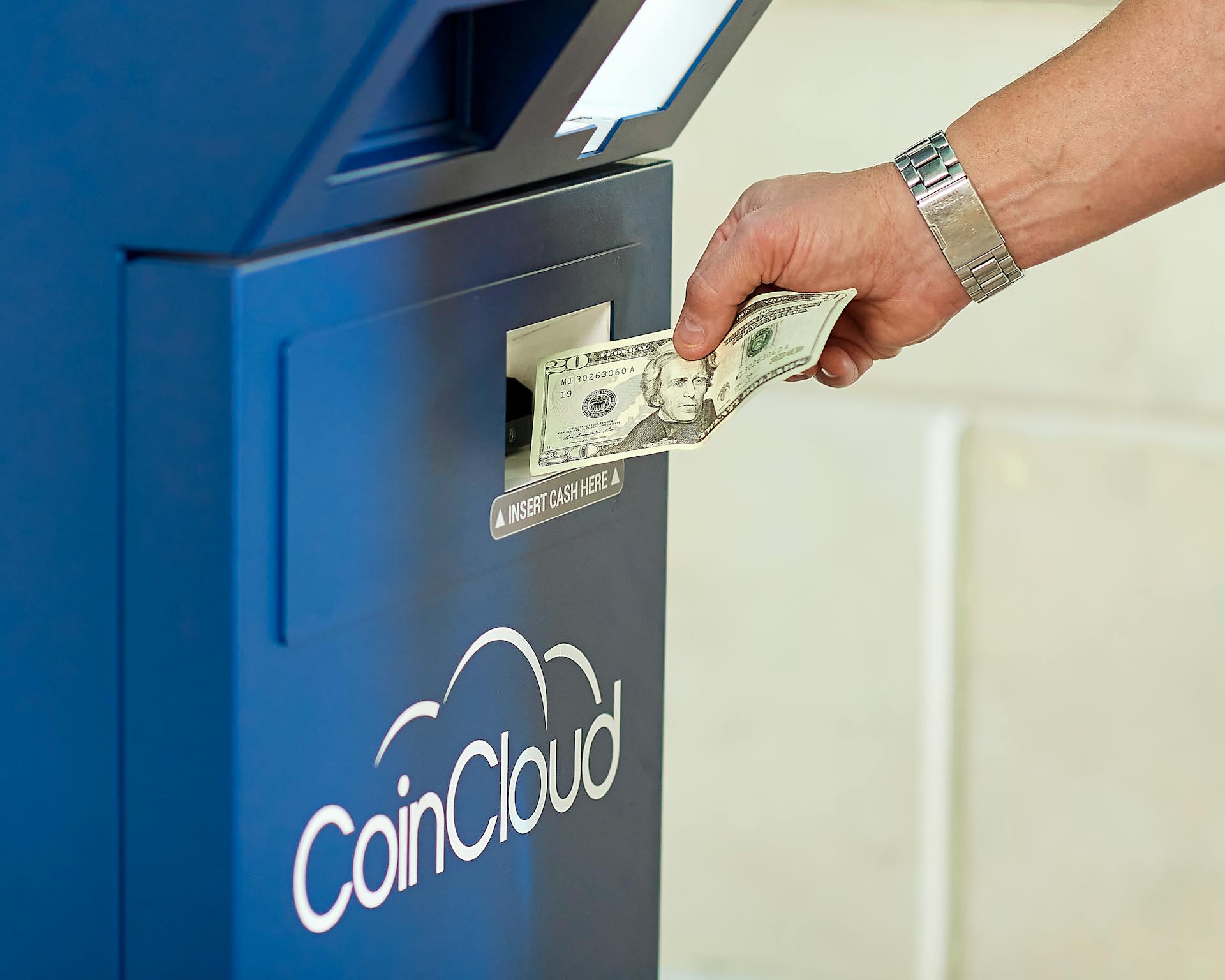
Skimming ATM machines is a serious issue that can put your financial security at risk.
Skimming devices are usually small, thin, and often resemble a credit card reader.
They can be installed on top of the ATM's card reader or attached to the side, making them hard to detect.
These devices are designed to capture your card information and PIN, which can then be used to steal your money or make unauthorized transactions.
The best way to avoid falling victim to skimming is to be vigilant and inspect the ATM before using it.
Check for any signs of tampering, such as scratches or glue residue, and make sure the card reader is secure and not loose.
What is Skimming?
Skimming is a type of ATM fraud where thieves attach a device to the card reader to steal your credit card information. This device is called a card skimmer.
A card skimmer is a device inserted in or on an ATM card reader, designed to steal credit card numbers and PIN codes from unsuspecting ATM users. Criminals can then use this information to create a new bank card and drain your account.
Card skimmers can be external devices that fit atop the ATM's card-reading port, collecting information from the magnetic strip on any cards inserted. They can also be very thin skimming devices inserted into the card reader directly or placed elsewhere inside the terminal.
These skimmers can read and collect information such as the cardholder's name, card numbers, CVV code, and expiration date when you try to deposit or withdraw cash.
How Common Is It?
Skimming at ATMs is a serious issue, and the numbers are staggering. More than 315,000 cards were compromised by skimming in 2023, according to FICO.
Skimming is a relatively easy crime to commit, especially with the rise of 3-D printing technology. Scammers can create an overlay device that can be installed by distracting store clerks.
The majority of card compromises happen at non-bank ATMs, often found at convenience stores or gas stations. In fact, non-bank ATMs accounted for most of the compromised skimming locations in 2023.
Intriguing read: Atm Machine Money Bank
Some states have seen a significant rise in skimming activity, with Virginia and Texas among the top five states with skimming activity. Virginia, Texas, New Jersey, Florida, and Colorado have all reported a rise of 50% or more in debit or credit card compromises.
EBT and other public benefits cards are particularly vulnerable to skimming because they often don't have a chip for secure payments. This lack of security can leave cardholders with limited protections and no reimbursement for benefits lost to criminals.
Methods and Types
Skimming ATM machines involves various methods and types of devices used by thieves to steal data from credit and debit cards. These methods have become increasingly sophisticated.
Classic skimmers are external devices that fit atop the ATM's card-reading port and collect information from the magnetic strip on any cards inserted. They can be very thin, almost impossible to detect.
Skimmers can also be inserted into the card reader directly or placed elsewhere inside the terminal to pull data from a card's chip. This type of skimmer is sometimes called a "shimmer."
Malicious devices can be attached to the exposed cables of a freestanding ATM to read and collect information such as the cardholder's name, card numbers, CVV code, and expiration date.
Tiny cameras can be placed on an ATM to record keypad entries and your fingers as you type. These cameras are often used in conjunction with other skimming devices.
Pinhole cameras are another common tool used in ATM skimming schemes. They can be placed inconspicuously to gather footage of victims' keystrokes on the PIN pad.
Keylogging pads can also be overlaid on top of the PIN pad to collect cardholders' PIN entries. This is a sneaky way for thieves to get your PIN.
Here are the types of skimming devices used by thieves:
- Skimmers: external devices that fit atop the ATM's card-reading port
- Shimmers: very thin skimming devices that can be inserted into the card reader
- Cameras: tiny cameras that record keypad entries and your fingers as you type
- Keyloggers: devices that collect PIN entries by overlaying the PIN pad
Skimmers are getting harder and harder to detect, especially with the advent of 3D printers and other inexpensive fabrication devices.
Prevention and Safety
Using ATMs in busy, well-lit areas can significantly reduce the risk of skimming. Thieves are more likely to target isolated ATMs where they can go unnoticed.
Covering your keypad with one hand when entering your PIN can prevent a camera from catching your PIN. However, this won't protect your PIN if there's a fake keypad attached.
Using a debit or credit card with chip technology is a more secure option. Chip technology is harder to replicate and less susceptible to skimming.
If you're unsure about the safety of an ATM, trust your gut and use a different one. There's no foolproof way to detect a skimmer, so it's better to err on the side of caution.
Regularly monitoring your bank account can help you catch suspicious activity early on. Check your account 2 to 4 times a week to ensure there's no unauthorized access.
Here are some key things to look out for when inspecting an ATM:
- Loose or damaged parts
- Signs of tampering
- A "cover" over the card reader
Go to the ATM on a weekday, as criminals often install skimmers on weekends when banks are closed. Your chances of finding a skimmer are lower on weekdays.
Using a mobile payment system like Google Pay, Apple Pay, or PayPal can also help reduce the risk of skimming. These systems use tokenization, which replaces your card number with a unique token for each transaction.
Identification and Detection
A skimmer typically looks like an ATM's card reader, so it's essential to examine the card reader for signs of tampering. Card readers should be sturdily attached to the machine.
Tape or glue residue on the keypad or card reader is a common sign of a skimmer device. You might also notice bulkiness on the card insert area or on the keypad.
To identify a skimmer, examine the card reader for any unusual items hanging from the ATM. A loose or ill-fitting PIN keypad is also a red flag.
When inspecting the card reader, wiggle it to see if it moves or budges. If it does, a skimmer is probably attached. Be wary of card readers that are not securely attached to the machine.
Small cameras are often attached to the ATM to get your PIN number after you enter your card. Look around for hidden cameras above the PIN pad, display screen, or in nearby structures.
Take a look at this: Do Atm Machines Have Cameras
A fake keypad may have larger or thicker keys than usual. It may also be raised up from the rest of the ATM. Check the keypad for any unusual thickness or larger keys.
Normal ATMs should not have skewed, covered, or cut-off graphics and shapes on the buttons. Check the buttons to see if lines, arrows, and other graphics are lined up properly.
If you use a certain ATM often, stay alert for any unusual changes. If you see something off, trust your gut and go to a new ATM.
Here are some signs to look out for when inspecting an ATM:
- Tape or glue residue on the keypad or card reader
- Bulkiness on the card insert area or on the keypad
- Unusual items hanging from the ATM
- Loose or ill-fitting PIN keypad
- Card reader that moves or budges when wiggled
- Hidden cameras above the PIN pad, display screen, or in nearby structures
- Fake keypad with larger or thicker keys
- Skewed, covered, or cut-off graphics and shapes on the buttons
- Unusual changes to the ATM
You can also use a skimmer scanning app to test for skimmers with your phone. These apps use Bluetooth to see if an ATM is sending information out to another phone or computer.
What to Do
To protect yourself from skimming ATM machines, it's crucial to be aware of the signs of tampering.
If you notice any unusual features on the ATM, such as scratches, dents, or missing screws, it's best to avoid using the machine altogether.
Cover the keypad when entering your PIN to prevent hackers from using cameras to capture your code.
Regularly check your account statements to catch any suspicious transactions early on.
What to Do If You've Been a Victim of Fraud
If you suspect you've been a victim of fraud, the first thing to do is contact local law enforcement. File a report with the police if you believe you've been scammed at an ATM.
It's also essential to report anything unusual about an ATM to the bank and suspicious card activity to your card issuer. This will help them take action to prevent further fraud.
If you've come across an ATM that appears to be tampered with, inform the shop clerk or bank branch workers immediately. They can take steps to secure the ATM and prevent further tampering.
If you believe your card has been compromised, contact your card provider to report the incident. They can freeze your card and re-issue a new one, and any fraudulent charges can be noted and reported to law enforcement.
Here are the steps to take if you suspect you've been a victim of fraud:
- Contact local law enforcement.
- Report anything unusual about an ATM to the bank.
- Report suspicious card activity to your card issuer.
- Contact your card provider to report the incident.
22 Thoughts on Skimmers
Skimmers are small devices that can be attached to ATMs or credit card readers, and can steal your card information in just a few seconds.
They're often difficult to spot, but one way to identify them is to check for any tape or glue that might be used to secure them.
Skimmers can be used to steal your card number, expiration date, and even your PIN.
Some skimmers are designed to look just like the real thing, making them nearly impossible to detect.
The average skimmer can store up to 1,000 card numbers.
Skimmers can be removed and reattached to different ATMs, making it difficult to track them down.
Discover more: Hacking Atm Machines with Just a Text
In some cases, skimmers have been found to be connected to a Wi-Fi network, allowing thieves to access the stolen information remotely.
Skimmers can be purchased online for as little as $50.
Skimmers are often used in conjunction with a fake keypad, which is designed to capture your PIN.
The majority of skimmers are installed at night, when the ATM is not being used.
Skimmers can be detected with a simple visual inspection, but it's also a good idea to use a card reader that can detect them.
Some ATMs have built-in skimmer detectors, which can alert you to the presence of a skimmer.
It's not uncommon for skimmers to be installed at ATMs in high-traffic areas.
Skimmers can be used to steal more than just credit card information - they can also be used to steal your identity.
Skimmers are a growing problem, with new types of skimmers being developed all the time.
In some cases, skimmers have been found to be installed at gas pumps.
Skimmers can be a major inconvenience, but they can also be a serious financial risk.
Readers also liked: Atm Machines Not Working
Frequently Asked Questions
Does tap to pay avoid skimmers?
Yes, tap to pay is generally safer than traditional payment methods because it uses Near Field Communication (NFC) technology that's resistant to skimming. This secure method only works over a short distance, making it harder for skimmers to intercept your card information.
Featured Images: pexels.com


